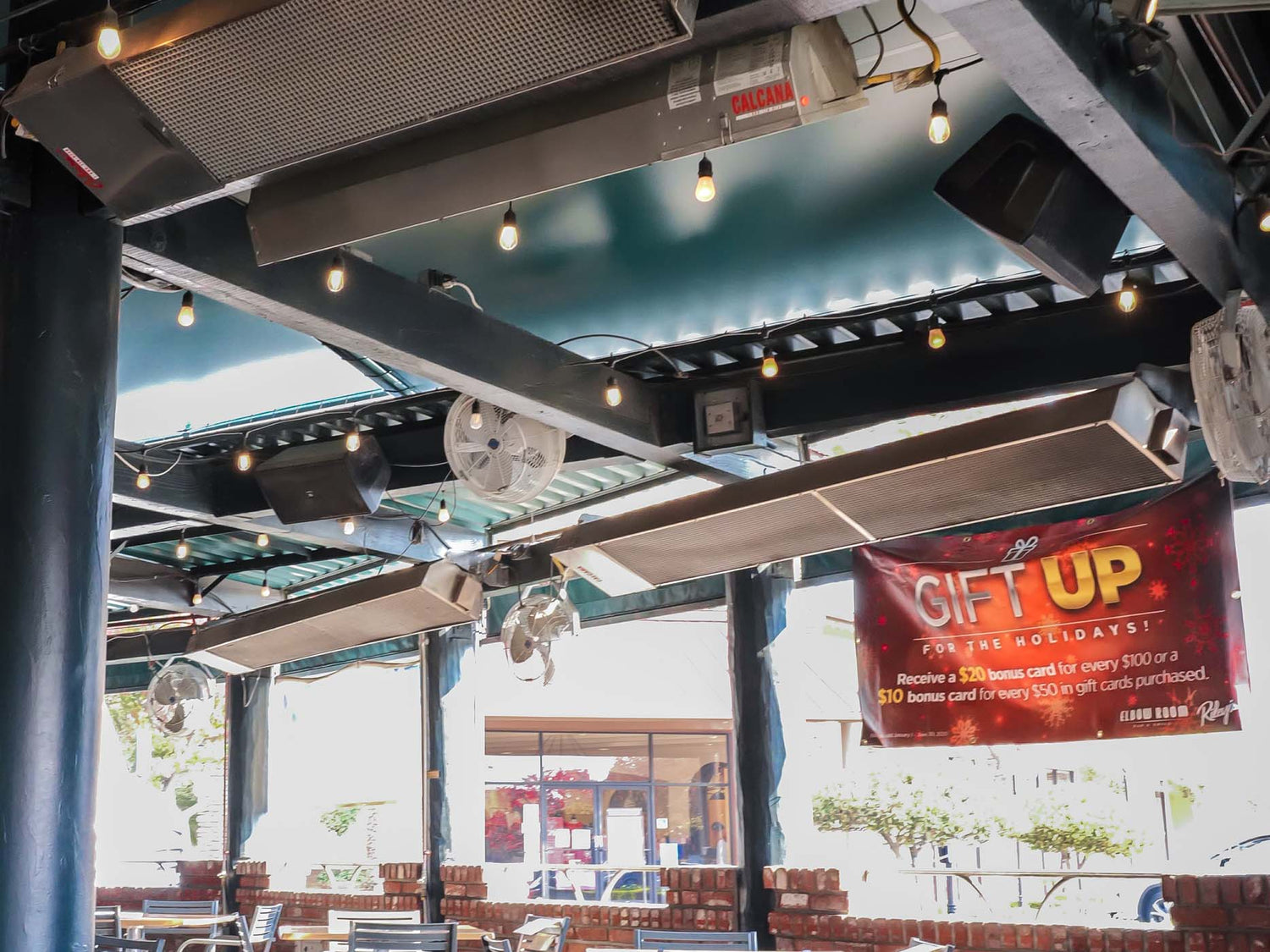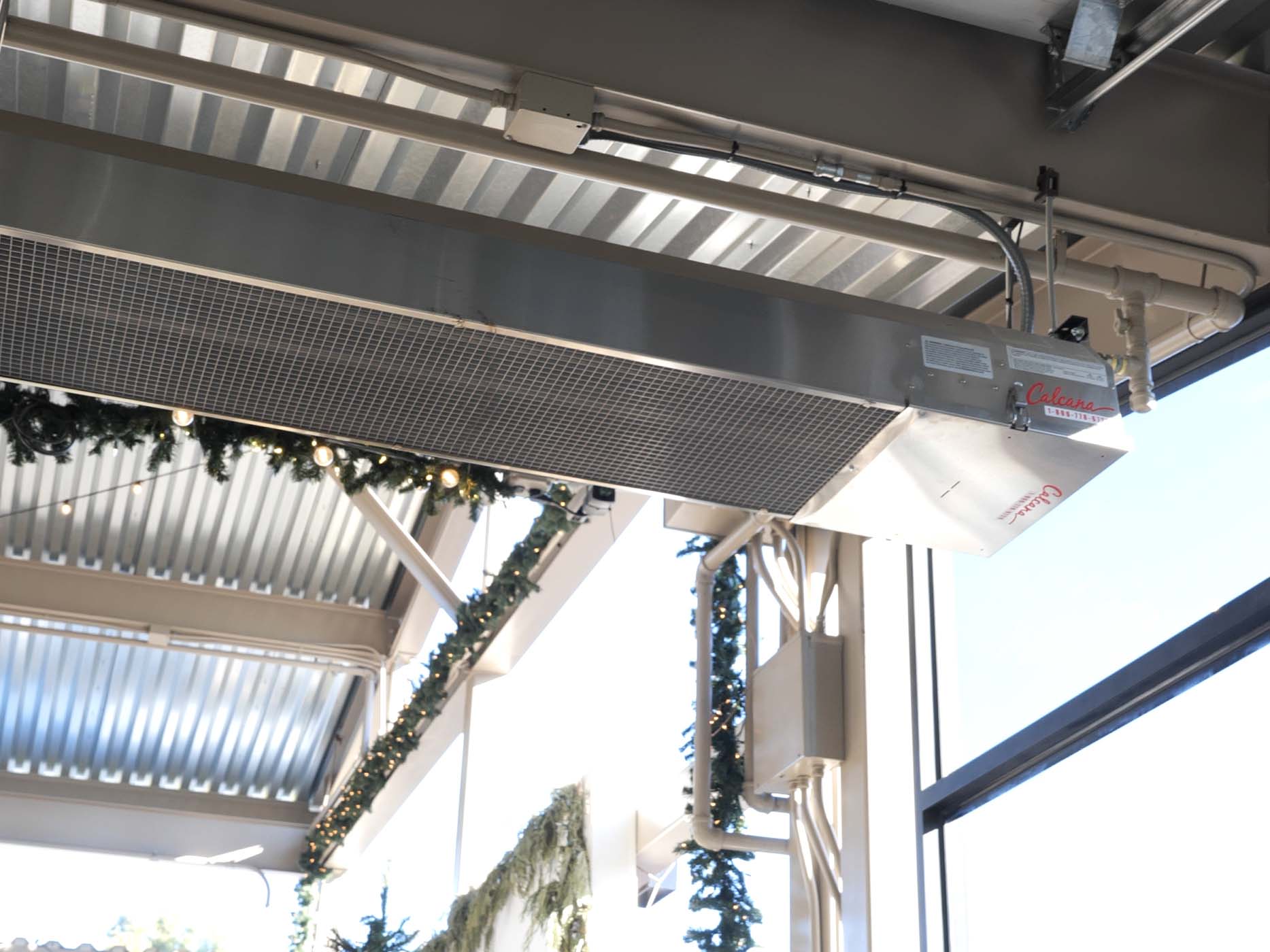When it comes to heating outdoor spaces, especially patios, terraces, or commercial dining areas, you’ve likely come across the terms infrared heat and radiant heat. While many people use these terms interchangeably, they don’t mean exactly the same thing. In fact, the confusion around “infrared vs radiant heat” can make choosing the right patio heating system more difficult than it needs to be. If you’re investing in outdoor comfort, whether for your home or business, it’s critical to understand the subtle but important distinctions between these technologies.
Understanding the difference between infrared radiant heaters and more general radiant heat heaters not only empowers you to make smarter purchasing decisions but also helps you create more efficient, cost-effective, and comfortable environments for family, friends, and guests. Whether you're looking to extend your outdoor season at home or increase capacity at your restaurant, choosing the right heater matters, not just for comfort, but for safety, efficiency, and long-term reliability.
In this blog, we’ll demystify the science of infrared or radiant heating, explain how each type works, explore their respective benefits, and help you determine which option is best for your space. From patios to pergolas, Calcana has been leading the way in outdoor heating innovation, and we’re here to give you the clarity you need to stay warm and comfortable, without wasting energy or money.
Let’s break down what makes infrared heat different from traditional radiant heat and why that difference is so important for your outdoor comfort strategy.
What is Radiant Heat? Understanding the Broader Concept of Heat Transfer
Radiant heat is one of the oldest and most natural forms of heating known to humankind. Unlike convection heat, which warms the air and relies on circulation to distribute warmth, radiant heat travels in waves and warms objects directly. Think of the sun on your skin on a crisp morning, you're feeling radiant heat. It doesn't matter if the air is cold; the rays penetrate and heat your body directly. That’s the fundamental principle behind radiant heat heaters.
Radiant heating systems emit infrared radiation that is absorbed by surfaces and people, which then radiate warmth throughout the surrounding area. While all infrared heating is radiant heating, not all radiant heating qualifies as infrared. Radiant heat is a broader umbrella term that includes various sources of radiant energy, such as infrared, visible light, or even ultraviolet rays, depending on the technology being used.
Understanding radiant heat’s role is critical because it helps highlight the limitations of traditional radiant systems when applied to open or semi-open spaces like patios. Conventional radiant systems may take longer to warm up or may not focus heat directionally, leading to energy waste and discomfort in outdoor environments. That’s where the targeted, directional power of infrared heat truly stands out.
What is Infrared Heat? Precision of Infrared Heaters
Infrared heat is a specific and highly efficient form of radiant heat. It operates using infrared radiation, an invisible spectrum of light just beyond what the human eye can see. When emitted from an infrared source, this energy travels in straight lines and directly heats objects, surfaces, and people without warming the surrounding air. This makes infrared radiant heaters incredibly effective, particularly for outdoor environments where wind and open air can quickly dissipate traditional forms of heat.
What sets infrared heat apart is its ability to provide targeted, almost instant warmth. When you stand near an infrared heater, the heat you feel is similar to the natural warmth of the sun, penetrating and immediate. Unlike convection-based heaters that work by circulating hot air, infrared systems heat the physical objects in their path, which then re-radiate warmth outward. This principle allows infrared heaters to be more energy-efficient, cost-effective, and environmentally friendly.
In essence, while all infrared heating is radiant in nature, not all radiant systems can match the precision, responsiveness, and outdoor efficiency of a well-designed infrared system. Infrared heat is not just a form of radiant energy, it’s the most advanced and focused version of it, perfectly tailored for environments where performance and comfort are equally important.
Radiant Heat vs. Infrared Heat: What’s the Difference?
While many people use the terms “radiant heat” and “infrared heat” interchangeably, there are important distinctions between the two, especially when it comes to choosing the best heating system for your outdoor patio. Understanding the nuances of infrared or radiant heating can help you make a more informed decision about comfort, efficiency, and performance.
Radiant heat is a broad category that describes any type of heat transfer that occurs through radiation, meaning heat that travels via electromagnetic waves without needing direct contact or air circulation. This form of heating is often associated with systems like heated floors, baseboard heaters, or ceiling panels that slowly warm up surrounding surfaces and air. Radiant systems are commonly used indoors, where the heat can be retained by walls, furniture, and flooring, allowing for long-term thermal comfort.
Infrared heat, on the other hand, is a specific type of radiant heat that uses a particular wavelength of infrared radiation to transfer energy. While all infrared heat is radiant, not all radiant heat is infrared. What sets infrared apart is its immediate, directional effect. Infrared radiant heaters focus heat exactly where it’s needed, on people and objects rather than air. This makes them uniquely effective in open or semi-enclosed spaces where air movement can disrupt traditional heating methods.
From a functional standpoint, the differences between radiant and infrared heat become especially noticeable outdoors. Radiant systems that rely on air to warm up the environment quickly lose their effectiveness in windy or open conditions. Infrared systems, however, deliver focused heat that remains effective regardless of outdoor airflow. That’s why infrared heat is often preferred for patios, garages, commercial terraces, and restaurant seating areas, places where controlling the environment isn’t always possible.
Why Infrared Heating Is Ideal for Outdoor Spaces
When it comes to heating outdoor environments, few solutions match the effectiveness and efficiency of infrared heating systems. Traditional heaters that rely on convection (heating the air) tend to struggle in open-air spaces because the warmth they generate is easily dispersed by wind and ambient temperature shifts. Infrared heating, however, offers a more targeted and resilient solution by warming people, furniture, and solid surfaces directly, regardless of surrounding air movement.
Infrared radiant heaters work by emitting invisible infrared rays that travel through the air and gently warm objects and people in their path, much like how the sun warms your skin on a cool day. This makes infrared heating incredibly effective in areas where retaining heated air is difficult, such as restaurant patios, open decks, rooftop lounges, garage workspaces, and warehouse docks.
One of the biggest advantages of using infrared heat outdoors is the immediacy of warmth. Unlike convection systems that need time to heat the surrounding air before you feel any difference, infrared heaters provide near-instant comfort. Within seconds of turning them on, the directed infrared rays begin to warm everything within reach, making them ideal for busy commercial settings where guest satisfaction depends on fast, reliable heat delivery.
Energy efficiency is another major benefit of infrared technology. Since infrared heaters don’t waste energy trying to heat the air, they consume significantly less fuel or electricity. For restaurants, cafes, or hospitality venues looking to cut operational costs while enhancing customer experience, infrared radiant heaters provide an unmatched return on investment.
Types of Infrared Radiant Heaters and How They Work
Understanding the different types of infrared radiant heaters is essential for choosing the best solution for your outdoor space. While all infrared heaters use the same core technology, emitting radiant energy to warm people and objects directly, there are several variations in how they operate, the fuel sources they use, and how they’re installed. Each type comes with distinct advantages that make it better suited for specific applications, whether you're outfitting a restaurant patio, warehouse loading dock, or residential deck.
Short-Wave vs. Medium-Wave vs. Long-Wave Infrared
Infrared heat is typically categorized by wavelength:
-
Short-wave (near-infrared) heaters produce intense, concentrated heat with a visible glow. These are ideal for open, windy spaces where powerful heat is needed quickly, such as ski lodges or exposed rooftop patios. However, they often emit bright light that can get extremly hot to the touch, and may disrupt the ambirance of the environment.
-
Medium-wave infrared heaters offer a balanced approach, providing strong radiant heat with slightly less light emission. These are commonly found in commercial settings and tend to strike a good compromise between efficiency, aesthetics, and safety.
-
Long-wave (far-infrared) heaters produce gentle, consistent warmth without visible light. This is the wave spectrum used by Calcana's infrared radiant heaters, which are designed to operate safely and efficiently without producing glare or discomfort. Long-wave heaters are particularly effective for semi-enclosed or enclosed patios where heat retention is important, but ambiance and safety are also key considerations.
Fuel Types: Natural Gas, Propane, or Electric
Infrared heaters can be powered by various fuel sources, each offering different advantages based on the installation site and intended use:
-
Natural gas infrared heaters are perfect for commercial applications with access to a gas line. These systems are cost-effective for long-term use and deliver consistent, high-output heat. Calcana specializes in these fuel-efficient systems, helping restaurants and businesses reduce energy costs without sacrificing comfort.
-
Propane-powered infrared heaters are ideal for locations where natural gas lines are unavailable. These units offer similar performance to natural gas models but with greater mobility and flexibility. Calcana’s propane systems are mounted and fixed, not portable, making them a safer and more permanent solution for commercial environments.
-
Electric infrared heaters are often used in residential or indoor/outdoor hybrid spaces. While easier to install in some settings, electric models may lack the output of gas-powered systems, especially in wide-open areas or very cold climates. They’re a good fit for small patios or balconies where localized heating is sufficient.
Patented Technology and Customization
Calcana’s patented infrared heating systems are also customizable to suit your layout, aesthetic, and capacity requirements. Available in a variety of lengths and heat intensities, each model is engineered to deliver even, targeted warmth across wide outdoor dining areas or large semi-enclosed spaces. The modular design of these heaters also allows for precise control, heating only the areas you need, when you need them, thus reducing energy waste and keeping operational costs low.
Whether you’re looking to upgrade a patio, enhance guest comfort, or create a four-season outdoor space, understanding the different types of infrared radiant heaters, and choosing the right fuel and mounting option, is the first step toward a more comfortable and cost-effective heating solution.
Choosing Between Infrared and Radiant Heating: What to Consider
When selecting the ideal outdoor heating system, understanding the nuanced differences between infrared and radiant heating is only part of the equation. The next step is evaluating which system aligns best with your space, usage patterns, and energy priorities. While all infrared heaters are technically radiant heaters, not all radiant heaters are created equal. Choosing the right system means balancing performance, aesthetics, cost, efficiency, and safety, all while keeping your long-term needs in focus.
Assessing the Type of Outdoor Space
Start by analyzing your space. Is it an open-air patio subject to wind and temperature fluctuations? Or is it a semi-enclosed area protected by walls or overhangs?
-
For open-air patios, where wind and open exposure can diminish traditional heating effectiveness, high-output infrared systems are essential. Calcana’s powerful infrared heaters are engineered to perform exceptionally well in these environments, delivering intense, focused heat that stands up to breezes while maintaining comfort across the space.
-
In semi-enclosed or enclosed spaces, long-wave infrared heaters, like those offered by Calcana, are ideal. They deliver consistent, comfortable warmth without bright light or unsafe surface temperatures, and they minimize heat loss thanks to structural containment.
Restaurants, breweries, and hospitality spaces often benefit from long-wave systems that prioritize ambiance and guest safety, while industrial or loading dock applications might require higher-output, fast-heating solutions.
Cost Considerations: Upfront vs. Long-Term
Initial costs can vary depending on the fuel type, heater style, and installation requirements. For example:
-
Portable propane heaters may have lower upfront costs but require ongoing cylinder replacements, offer less control, and may incur higher per-hour fuel expenses.
-
Calcana’s fixed natural gas or propane infrared systems, though requiring professional installation, often pay for themselves through lower energy use, reduced maintenance, and long-term durability.
In environments where heaters are used daily for extended periods, such as outdoor dining venues, investing in a permanent system is often far more cost-effective over time. The lower operating cost and longer lifespan of Calcana’s heaters make them a smart business decision.
Conclusion: The Case for Informed Heating Choices
Understanding the distinction between infrared and radiant heat is more than just splitting hairs, it’s the key to making an informed, cost-effective decision for your outdoor heating needs. While the terms are often used interchangeably, knowing the difference helps you select the right technology that performs reliably in real-world conditions. For outdoor environments in particular, where open air, changing weather, and energy efficiency are top priorities, infrared radiant heaters offer unmatched advantages in both performance and value.
With infrared radiant heating, you're not just warming the air, you're warming people, objects, and surfaces directly. This means less energy is wasted, comfort is felt faster, and heat is delivered exactly where it's needed, even in windy or drafty spaces. That level of precision is what separates infrared heaters from generic “radiant” systems or traditional convection heaters. When it comes to outdoor comfort, precision isn’t just a perk, it’s a necessity.
Choosing Calcana: A Smart, Lasting Investment
When you choose Calcana’s infrared radiant heaters, you’re choosing a product that embodies quality engineering, proven energy savings, and architectural flexibility. Whether you’re creating a cozy backyard oasis, upgrading a restaurant’s patio, or retrofitting a commercial venue for year-round use, Calcana’s systems are designed to adapt to your space and elevate your experience.
By leveraging patented design technology, advanced reflectors, and modular system controls, our heaters provide high-performance heating without the pitfalls of noisy fans, open flames, or bulky equipment. You’re not just investing in warmth—you’re investing in a long-term comfort solution that supports your goals, from customer satisfaction to operational efficiency.
Infrared or Radiant Heating? Now You Know the Difference
So, the next time you hear someone ask about infrared or radiant heating, you’ll be able to explain that not all radiant heat is infrared—but all of Calcana’s infrared heaters are radiant. That distinction matters when you're aiming for comfort that’s consistent, efficient, and specifically engineered for the demands of outdoor living and commercial hospitality.
When you're ready to make the switch, or upgrade your current system, remember that understanding the science behind the heat gives you the power to choose wisely. And with Calcana, that choice leads to reliable, safe, and energy-efficient outdoor comfort all year long.




Leave a comment
This site is protected by hCaptcha and the hCaptcha Privacy Policy and Terms of Service apply.